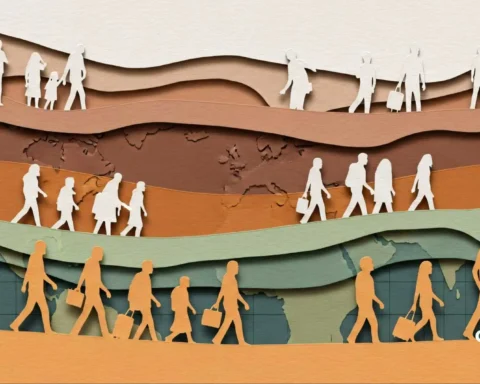The entire world is being shaken up by man-made climate disasters. The news is up to the brim with hurricanes, floods, drought, heat waves, and heavy rains in several parts of the world. When the climate (and not the weather) changes, it can have catastrophic effects.
The future of Earth and its inhabitants is becoming dicier by the day, thanks to climate disasters, which are fundamentally man-made. Not many leaders seem to keep awake at night since they know well that their selfish conduct in the past will see them through any quagmire. But that is not so the case for the citizens who are at the mercy of the ‘climate Gods’ and the ‘leader Gods’.
What are the citizens supposed to do?
This article explores the possibilities that could have been in the backdrop of hurricane Beryl which devastated parts of the Caribbean in July 2024. The focus is on Grenada which has been substantially devastated by the recent hurricane Beryl. The article also looks into their citizenship investment program. How much have funds from the Citizenship by Investment (CBI) been used to prevent or mitigate the aftereffects? Let us find out.
Table of Contents
The Caribbean
The Caribbean has always borne the brunt of storms. The geographical position lends itself to high moisture-laden clouds from the Atlantic to deliver heavy winds and rains. Huge devastation is an accepted norm. The island nations suffer the after-effects of climate change due to global warming mostly caused by developed countries and developing countries.
YOU MIGHT BE INTERESTED IN: The Ultimate Guide to Caribbean Citizenship by Investment in 2024
Hurricane Beryl’s Path and Strength
In July 2024, Hurricane Beryl, originating as a tropical depression in the Atlantic basin, intensified and made landfall in Grenada, a southeastern Caribbean volcanic island, while its eye raked Jamaica’s coast as it continued its movement.
Hurricane Beryl reached Category 4 status on the Saffir-Simpson Hurricane Wind Scale, with sustained winds of 130-156 mph (209-251 km/h). Some reports suggest it briefly reached Category 5 strength, with winds exceeding 157 mph (252 km/h). Despite being downgraded to a Category 2 storm, Hurricane Beryl left a lasting impact on the affected regions.
It is considered the earliest storm in history to develop into a Category 5 hurricane in the Atlantic, causing significant damage in Grenada, Jamaica, and Dominica, with power lines down, homes flattened, and streets flooded. At least seven people were reported dead. Beryl made record landfall in Grenada, particularly on Carriacou Island.
The intensity and trajectory of Hurricane Beryl underscore the need for robust disaster response and preparedness measures.
Beryl’s Impact in the Caribbean
Hurricane Beryl had a significant impact on the Caribbean islands, causing widespread damage to infrastructure. Power lines were disrupted, causing electricity supply issues and homes to be damaged. Heavy rainfall and storm surges caused flooding, road damage, and erosion. Storm surges damaged coastal infrastructure, beachfront properties, and seawalls, and threatened sea turtle nesting sites. Urgent repairs are needed to restore power, water, and communication networks, as well as rebuild damaged homes and infrastructure.
Despite the challenges, recovery efforts are underway to address the aftermath of Hurricane Beryl.
Impact on Grenada
Hurricane Beryl, a Category 4 hurricane, caused significant damage in the southeast Caribbean islands, particularly Grenada, resulting in three deaths and over 1,600 people seeking shelter, with the number expected to double. The hurricane has affected approximately 200,000 people (nearly the entire population of both Grenada and SVG). With an unemployment rate of 29% in Grenada (ILO,2022), it is a nation grappling for economic survival.
Grenadian Prime Minister Dickon Mitchell described the situation as grim, with water, food, and baby formula as priority relief efforts.
Scattered debris and houses with missing roofs
The hurricane caused significant damage to Grenada’s islands, with over 90% of homes and buildings destroyed or severely damaged. Islands, Carriacou, and Petite Martinique (part of Grenada) experienced almost total destruction, agriculture, and the natural environment, while the electrical grid system and communication infrastructure were also significantly impacted.
Check out our Destinations Page on Grenada.
Grenada Citizenship Program Funds
The funds generated from Grenada’s Citizenship by Investment (CBI) program are used for various purposes aimed at promoting the country’s economic development and social welfare.
Grenada’s CBI program, which generated a fiscal surplus of 8% of GDP in 2023, has used the surplus to fund its Disaster Resilience Strategy, including the construction of 5,000 climate-resistant homes, infrastructure projects, and ecotourism improvements.
Grenada is pursuing renewable energy goals (100% by 2030), including a geothermal project, with CBI funds. The program supports a Department of Creative Economy, sustainable economic activities, and ecotourism initiatives. The Saudi Fund for Development provides a $100 million loan for climate risk mitigation.
Starting in 2023, the government recorded all CBI receipts as non-tax revenue, with 10% transferred to the Contingency Fund, and approved an annual report detailing inflows, transformational projects, and the fund’s stock.
Grenada’s CBI program funds marine conservation projects like the Sperm Whale Reserve, while the 2015 Integrated Coastal Zone Management Policy and Act promotes a blue economy by regulating coastal zone use and protection.

Challenges in the Implementation of Projects
Climate model projections and future impacts pose uncertainties, making it challenging to plan and design climate-resilient infrastructure projects. Flexible, adaptive approaches are needed to reduce costs and mitigate uncertainty. Caribbean countries must balance new infrastructure development with upgrading existing ones to mobilize financing.
Sufficient research and development programs have to be initiated to understand climate change and the scientific solutions for long-term benefits.
Sectors where CBI Funds are Used
Grenada’s Citizenship by Investment (CBI) funds are utilized in various sectors to enhance climate resilience, with key sectors typically allocated for these purposes.
Infrastructure development involves investing in resilient projects like roads, bridges, coastal protection measures, and drainage systems to withstand climate-related hazards like floods, storms, and sea level rise. Natural Resource Management involves funding initiatives for biodiversity conservation, sustainable land management, reforestation, and marine protection to preserve ecosystems and mitigate climate change impacts.
The Water Resource Management project aims to enhance water availability, efficiency, and quality by investing in water storage, irrigation systems, watershed management, and water conservation practices. Supporting Disaster Risk Reduction (DRR) measures like early warning systems, community-based disaster preparedness, and capacity building can help mitigate the vulnerability to natural disasters exacerbated by climate change.
Promoting renewable energy projects like solar, wind, and geothermal to reduce fossil fuel dependency, mitigate greenhouse gas emissions, and improve energy security in a changing climate.
CBI funds can significantly enhance Grenada’s capacity to adapt to climate change impacts and promote sustainable development in strategic sectors.
OUR ARTICLES ON GRENADA:
- Grenada Citizenship By Investment Program: EVERYTHING You Need To Know
- Here’s How to Fast-Track Grenada Citizenship By Investment Processing Time
- Grenada Citizenship By Investment Cost: Can You Really Afford It?
- How to Prepare for the Challenges of Doing Business in Grenada
Programs for Well-being in Grenada
Unemployment Income Program in Grenada
The UI program in Grenada aims to reduce climate change vulnerability, job and income losses, and worker income protection. It also aims to improve financial sustainability and reduce government fiscal pressures during natural disasters. Funded by Grenada’s Citizenship by Investment program, it focuses on income security, disaster risk management, and resilience against climate risks and natural hazards.
Hurricane Beryl damage in Grenada
Grenada’s Universal Insurance program provides 50% wage replacement for up to 13 weeks to private and public sector workers, benefiting low-wage earners more than higher earners. By December 2024, at least 40,000 workers are expected to contribute to the permanently funded program, enhancing income protection and disaster risk management. Funded through the CBI initiative, it demonstrates Grenada’s commitment to innovative financing mechanisms.
Grenada’s Hazard Mitigation Policy
Grenada’s Hazard Mitigation Policy outlines strategies to mitigate risks from natural disasters like hurricanes, floods, and landslides, including key details.
Risk assessment involves a thorough evaluation of potential hazards, vulnerabilities, and exposure of communities, infrastructure, and natural resources to both natural and man-made threats. The focus is on enhancing early warning systems to inform communities and authorities about potential hazards, enabling timely evacuation and preparedness measures.
Infrastructure resilience involves incorporating resilience considerations into planning and development to ensure critical infrastructure, including buildings, roads, bridges, and utilities, can swiftly recover from disasters. The initiative focuses on enhancing disaster preparedness and response plans within the community through training programs, public awareness campaigns, and community drills.
Environmental management involves implementing sustainable land use planning, ecosystem protection, and natural resource management to mitigate disaster risks and enhance ecological resilience. Policy coordination involves coordinating efforts among government agencies, private sector partners, civil society organizations, and international partners to ensure a unified approach to hazard mitigation and disaster risk reduction.
Legislation and governance involve the creation and enforcement of policies and regulations that aid in hazard mitigation and enhance institutional resilience to disaster risks.
Grenada’s Hazard Mitigation Policy aims to create a resilient nation, minimizing disaster loss, promoting sustainable development, and safeguarding citizens’ well-being amid rising climate-related risks.
Disaster Management Act
The 2023 Disaster Management Act in Grenada aims to enhance the country’s preparedness and response to natural and man-made disasters by establishing the National Disaster Management Agency and coordinating emergency activities, consolidating various disaster risk management efforts, enhancing climate resilience, and guiding national policy.

The Act mandates ministries and agencies to create Operations Continuity Plans by 2024, with a 50% compliance rate, to enhance disaster preparedness and response to climate-related disasters. It incorporates climate risk considerations into infrastructure planning, design, and construction standards, and may establish mechanisms for financial resource mobilization for disaster risk reduction and climate adaptation measures.
The Disaster Management Act in Grenada enhances climate resilience by consolidating efforts, improving preparedness, supporting resilient infrastructure, and facilitating financing, making it a vital part of the country’s strategy.
National Adaptation Plan (NAP)
Grenada’s National Adaptation Plan (NAP) was established from 2017 to 2021 to tackle climate change challenges and enhance resilience across sectors. It includes 12 programs focusing on water management, ecosystem preservation, food security, public health, and integrated coastal zone management. The plan also emphasizes public awareness and education about climate change impacts.
Grenada’s National Adaptation Plan prioritizes gender equality and vulnerable groups’ needs in climate resilience planning, integrating social inclusion principles for equitable distribution of adaptation benefits.
Grenada is using its CBI program to fund renewable energy projects, focusing on eco-tourism and environmental preservation. The nation plans to transition to renewable power generation through increased private and donor-based financing, improved regulatory framework, and a National Energy Plan, acknowledging the IMF’s ambitious goals.
Grenada is investing in a geothermal energy project and diversifying energy sources through solar and wind projects, partially funded by its CBI program. The 1.1 MW wind farm on Carriacou will be used to enhance Grenada’s regulatory framework and National Energy Plan.
Protecting Grenada’s tourism assets
Tourism, a major contributor to its GDP (23.3%), Grenada is implementing measures to safeguard its tourism assets from the adverse effects of climate change.
In 2011, Grenada launched the Strategic Program for Climate Resilience (SPCR) to promote information sharing on disaster vulnerability, climate risk reduction, and data management, while implementing community-level adaptation projects for water resource management and coastal protection.
Grenada is mapping infrastructure assets to identify climate risks and natural hazards, taking actions to enhance resilience, including land raising and coastal infrastructure segmentation, as key coastal tourism assets, including beaches and resorts, are at risk.
Grenada is implementing a Coastal Zone Management Policy and Act to regulate tourism-critical coastal zones, identify threats, and enhance resilience. It is also introducing eco-hotels and resorts to mitigate climate change’s effects.
Implementing climate resilience initiatives faces challenges such as overcoming institutional silos, effectively communicating with the public, and ensuring projects are tailored to local needs.
National Sustainable Development Plan
The National Sustainable Development Plan (NSDP) 2020-2035 is crucial for Grenada’s tourism sector, aiming to build climate and disaster resilience by considering tourists, businesses, local communities, and social, economic, and environmental issues, and guiding Grenada towards its 2035 vision.
The NSDP aims to promote environmental sustainability and security in Grenada by focusing on climate resilience, hazard risk reduction, and sustainable resource use. It advocates for modern climate and disaster-resistant infrastructure and a competitive business environment for tourism enterprise growth.
The NSDP has prioritized tourism in Grenada, alongside agriculture, creative industries, and maritime activities, recommending diversification and strengthening intersectoral linkages to boost industry resilience.
Other Initiatives for Climate-Based Solutions
In the realm of climate-based solutions, some of the initiatives are the Pilot Program for Climate Resilience PPCR and the Climate Investment Fund (CIF) in the Caribbean pertain to Haiti,
Jamaica. St. Lucia, and St. Vincent and the Grenadines. We will focus on Grenada here.
Pilot Program for Climate Resilience (PPCR)
The PPCR in Grenada is supported by multiple international agencies, including the World Bank, the Inter-American Development Bank (IDB), and the Caribbean Development Bank (CDB).
Projected change in temperature and precipitation
The Disaster Vulnerability and Climate Risk Reduction Project in Grenada aims to enhance disaster and climate risk management through infrastructure investments like coastal defenses and drainage systems. The project aims to enhance water resource management to ensure reliable supply amidst climate change impacts by upgrading infrastructure and implementing conservation measures.
The initiative promotes climate-resilient agriculture, enhancing food security and farmers’ livelihoods by introducing sustainable farming practices and technologies. The project aims to enhance local communities’ resilience to climate-related hazards through training and capacity-building activities. Climate Smart Cities is an initiative promoting sustainable urban planning and development that incorporates climate resilience principles to create resilient urban areas.
Climate Investment Funds (CIF)
The Climate Investment Funds (CIF) are a group of multilateral climate finance mechanisms that support developing countries in their transition to low-carbon, climate-resilient economies. CIF operates in over 80 countries, focusing on projects ranging from renewable energy installations to climate-smart agriculture and disaster risk reduction.
The Climate Investment Funds (CIF) investments have enhanced Grenada’s forest and water resource management departments, enhancing resilience planning and decision-making. Infrastructure improvements focus on flood protection and urban drainage to mitigate climate change impacts. Investments are exploring innovative financing mechanisms for post-disaster recovery. It provides funding for climate action and sustainable development projects, with programs like the Clean Technology Fund, Forest Investment Program, and Pilot Program for Climate Resilience.
The Climate Investment Funds’ Technical Assistance Facility has allocated $350,000 for technical assistance activities to enhance energy efficiency and renewable energy deployment in Grenada. The World Bank and regional development banks such as the Inter-American Development Bank (IDB) and the Caribbean Development Bank (CDB) are key partners in providing technical assistance and funding.
Schools and health clinics have been constructed or rehabilitated to withstand climate-related shocks, benefiting communities across Grenada.
Climate Program Office (CPO)
The Climate Program Office (CPO) in Grenada is enhancing the island’s climate resilience through various initiatives under the National Oceanic and Atmospheric Administration (NOAA) in the United States.
Climate-Resilient Water Sector in Grenada (G-CREWS): The objective is to improve the water sector’s climate resilience through climate-resilient management, water use, facilities, and regional learning and replication.
Integrated Climate Change Adaptation Strategies (ICCAS): The goal is to enhance climate change resilience in vulnerable communities and ecosystems through integrated adaptation strategies, including the establishment of the Community Climate Change Adaptation Fund, operational guidelines, and the ICCAS Community Liaison Network.
Grenada’s climate resilience projects, in collaboration with UNDP and GIZ, aim to enhance water management, community adaptation, and sustainable practices, enhancing climate resilience.
Civil Society Innovations
The Caribbean Climate Innovation Series showcases climate actions by civil society organizations and partners, promoting resilience and inclusive decision-making across the region through scaling up or replication.
Grenada’s civil society is actively reducing plastic pollution through the Grenada Solid Waste Management Authority and the Grenada Hotel and Tourism Association. Hotels are now sorting waste and delivering plastics to the GSWMA Recycling Centre, promoting sustainable tourism practices. The Grenada Green Group launched a ‘Plastic Bottle Collection Campaign’.
The Grenada Green Group (G3, an NGO) campaign started on June 8, 2024 (World Ocean Day), supported by the Recycle OECS Project, of the Organisation of Eastern Caribbean States promotes public awareness and active participation through weekly events and recycling depots across the island.
Innovative Studies and Solutions
Let’s explore some innovative studies and related solutions that enhance climate resilience in CBI projects across Grenada.
Caribbean Natural Resources Institute (CANARI)
The Caribbean Natural Resources Institute (CANARI) in partnership with the Government of Grenada (GOG), Commission of the Organisation of Eastern Caribbean States (OECS), and the United Nations World Conservation Centre (UNEP-WCMC). Collaborative efforts focused on natural resource management, conservation, and sustainable development in Grenada include fostering collaborations to effectively manage and preserve Grenada’s biodiversity, forests, marine resources, and ecosystems.
Grenada is promoting sustainable development by integrating environmental considerations into its development planning, ensuring economic growth, and preserving natural resources. The initiative aims to enhance local capacity through training, workshops, and knowledge-sharing activities to improve environmental governance and community engagement in natural resource management.
The organization provides technical expertise and advice to the Grenada government and the OECS Commission on environmental policies, regulations, and strategies for conservation and sustainable development.
CaribSAVE Climate Change Risk Atlas (CCCRA)
The CaribSAVE Climate Change Risk Atlas (CCCRA) is a tool designed to assess climate change risks, vulnerabilities, and adaptive capacities in Caribbean countries.
In Grenada, as part of the CCCRA, the assessment includes the process of identifying climate change risks involving assessing potential impacts such as sea level rise, precipitation changes, and increased frequency of extreme weather events. The assessment of vulnerabilities involves assessing sectors and communities that are particularly susceptible to climate impacts, including coastal communities, agriculture, infrastructure, and human health.
The analysis focuses on understanding the existing strategies and capabilities, such as policies, infrastructure resilience, and community preparedness, to effectively cope with and adapt to climate change. The assessment will lead to the development of recommendations and strategies for enhancing resilience and adaptive capacity, potentially through policy interventions, infrastructure improvements, and community engagement.
Integrated Vulnerability Assessment (IVA)
The Integrated Vulnerability Assessment (IVA) for Grenada is a comprehensive evaluation that examines the country’s susceptibility to various risks associated with climate change. This assessment typically examines the potential impacts of climate change on Grenada, including changes in temperature, rainfall patterns, sea level rise, and extreme weather events.
The study evaluates vulnerabilities in key sectors like agriculture, tourism, infrastructure, water resources, coastal areas, and human health. It explores the vulnerability of communities and economic activities to climate impacts, examining their impact on livelihoods, food security, and socio-economic development.
The study assesses Grenada’s capacity to adapt to climate change impacts, focusing on its existing policies, infrastructure resilience, and community-based adaptation initiatives. The report proposes strategies to enhance resilience and adaptive capacity, aiming to minimize vulnerabilities and promote sustainable development in response to climate change.
The Integrated Vulnerability Assessment is a crucial tool for Grenada’s policymakers, planners, and stakeholders to prioritize climate adaptation measures and integrate resilience-building efforts into development planning.
Projects
Storm-Resistant Houses
Grenada continues to construct storm-resistant homes as part of its efforts to combat climate change and enhance natural disaster resilience. Homes are designed with elevated living spaces on the second floor, 16 feet above sea level, to protect against flooding during storms. The entire structure is securely tied together using metal strapping, ensuring a cohesive unit capable of withstanding strong winds. Ground floors are designed as garages with flood vents, allowing rising water to flow through, minimizing damage and preventing structural instability.
Elevating the house for protection against floodwater
Challenges in Using CBI Funds
The Caribbean nations face challenges in financing climate resilience projects, and integrating climate resilience considerations into policy areas like spatial planning, infrastructure appraisals, and regulatory standards can be challenging in practice.
Resource allocation for disaster relief may divert funds from long-term development projects, and prioritizing urgent needs like immediate relief or sustainable development is a complex task.
The CBI funds support long-term projects like infrastructure, education, and healthcare, requiring time for planning and impact assessment. Immediate crises require swift action, requiring immediate relief.
Climate Smart Agriculture (CSA)
The balancing act aims to ensure transparency in fund allocation and address emergencies, while public perception can be eroded by mismanagement or delays. Adaptive strategies involve flexible frameworks for long-term development and rapid response, as well as scenario planning for disaster anticipation and contingency plans. Community participation in the funds is crucial for ensuring their needs are considered and allowing them to have a say in emergency management.
In summary, striking the right balance between immediate relief and sustainable development requires careful planning, collaboration, and responsiveness.
READ OTHER ARTICLES ON CITIZENSHIP BY INVESTMENT (CBI):
Addressing Public Resistance to its Climate Resilience Projects
Grenada faced some public resistance to its climate resilience efforts, particularly around the development of its Strategic Program for Climate Resilience (SPCR).
The government effectively addressed public resistance to the SPCR project by effectively communicating its outcomes, resources, and support for relocating villages, ensuring the public was not worsened and that the project was not a rebranding of failed projects. The SPCR identified vulnerabilities in coastal areas at high risk of sea level rise and designed projects to address these needs, demonstrating their relevance and value to local communities.
The government facilitated cross-sectoral collaboration to address public concerns about the SPCR’s “top-heavy” (upfront costs) nature and its inability to effectively connect with local stakeholders and communities. The government tackled institutional issues by enhancing agency communication, resolving overlapping roles, and minimizing duplication of efforts for a more cohesive approach.
Grenada’s experience emphasizes the significance of transparent communication, local adaptation of climate resilience initiatives, cross-sector collaboration, and overcoming institutional silos to effectively tackle public resistance and build widespread climate adaptation support.
Lessons Learned from Hurricane Beryl
Hurricane Beryl has provided valuable lessons for enhancing future emergency response strategies using CBI funds.
Swift allocation of CBI funds is vital during disasters, as pre-allocated budgets can expedite relief efforts. Community resilience is crucial, and investing in CBI funds is essential for effective disaster management through local capacity-building. Adaptive planning involves flexible CBI spending that adjusts based on disaster impact, while scenario-based planning prepares for varying emergencies.
Clear guidelines for CBI fund utilization are fundamental, and regular reporting ensures transparency and accountability. Strengthening institutional coordination and capacity is crucial for small island states with limited resources to effectively manage climate risks and data. Grenada has adopted lessons from past hurricanes to prioritize disaster preparedness and climate resilience, utilizing past disaster experiences to inform effective adaptation strategies.
In summary, Beryl emphasizes the need for agile, community-focused, and adaptable emergency response strategies supported by CBI funds.
Recommendations for CBI
We underline the need for all nations (especially island nations and coastal regions) to take long-term and sustainable preventive measures to achieve climate resilience.
Hurricane Beryl caused extensive damage in the Caribbean islands, causing widespread damage to infrastructure, homes, and communities, necessitating emergency response efforts such as evacuations, shelters, and relief supplies. CBI funds are used to enhance infrastructure and public facilities through various methods such as taxes, bonds, grants, and impact fees. Accurate assessment of destruction including inadequacy of infrastructure has to be carried out. This will initiate a database for each region that could support forthcoming authorities to act upon.
Efficient allocation is crucial for disaster recovery, but challenges such as competing priorities, bureaucratic hurdles, and changing needs pose significant challenges. A wise strategy is to emphasize the importance of strengthening infrastructure resilience, improving CBI planning, and implementing proactive measures for future hurricanes.
The advocacy for better coordination between CBI funds and disaster response emphasizes timely utilization and flexibility, evaluating community infrastructure spending’s effectiveness by assessing the speed of restoration and resilience and considering bureaucracy and resource constraints.
Caribbean nations face challenges in financing climate resilience projects and integrating climate resilience considerations into policy areas like spatial planning, infrastructure appraisals, and regulatory standards. Long-term financial and resource planning should align with adaptation strategies and investments in resilient infrastructure.
Audit reports could be publicized in order to gain trust among the citizens and thereby incentivize them to participate in more projects. Entrepreneurs – existing and new, may be able to build their businesses on the back of preventing future climate disasters, contributing to the development of the nation while attaining profits.
By increasing transparency, the government can urge public participation. Any resistance by the civil society can be reduced allowing projects to move ahead smoothly. The trisome collaboration of government-public-private ventures can ensure the optimum participation of all stakeholders.
ALSO READ: The Hypocrisy? A Critical Look at Citizenship by Investment Programs and Reparations
Urban Design and Architecture
Sustainable design of cities and towns can mitigate the effects of stormwater and flash floods. The concept of a ‘sponge city’ is considered a solution. A sponge city is a sustainable urban design that uses green infrastructure to combat climate change’s effects on rainfall and flooding. It incorporates urban parks, gardens, green spaces, wetlands, and permeable pavements to capture, retain, and absorb excess stormwater, reducing the risk of flash floods.
As far as urban design principles go, the right zoning regulations have to be implemented. Proper land use planning involves avoiding construction in high-risk areas like coastal zones and ensuring critical infrastructure is located in safer areas. Hurricane-resistant construction has to be mandated.
More community shelters can be included in the budgets of cities and towns. The focus should be on designing and constructing structures that can withstand extreme weather conditions and offer a safe haven during hurricanes.
On the architectural aspect, wind-resistant design involves creating buildings with aerodynamic shapes and features, such as hip roofs and fewer overhangs, to minimize wind pressure on the structures. Building materials like reinforced concrete, hurricane-resistant windows, and metal roofs could be used to withstand high winds and water damage. Robust drainage systems can be implemented to prevent flooding and effectively manage stormwater.
Regular maintenance and upgrades are crucial for maintaining and enhancing infrastructure and buildings to meet the latest safety standards and address any vulnerabilities. Green infrastructure involves incorporating natural barriers like mangroves, wetlands, and coral reefs to absorb storm surge energy and reduce flooding. As far as utilities are concerned, the focus must be on ensuring the operational continuity of power, water, and communication systems during and after a hurricane.
The integration of urban design with comprehensive emergency response plans, including clear evacuation routes and accessible emergency services, is crucial for effective disaster management. Policy regulation should also be on raising public awareness about hurricane preparedness, and the significance of adhering to building codes and safety guidelines.
ALSO READ: The Bizarre World of Citizenship by Investment: Where Due Diligence Takes a Vacation
Conclusion
The aftermath of Hurricane Beryl is a sobering reminder of the power and impact of natural disasters. Recovery and rebuilding efforts will be crucial for affected communities. The storm caused immense destruction, impacting homes, businesses, and infrastructure.
Some island nations have not been affected by Hurricane Beryl. That does not mean that they will not be in the eye of a storm or in the path of a storm in the future. Even these nations are urged to take preventive measures as climate change is going at a faster pace than originally predicted. Fighting climate change cannot be done in isolation.
At its best, CBI can adopt a wholesome approach including community engagement, capacity building, ecosystem-based approaches, climate-resilient infrastructure, monitoring and evaluation, and policy integration. Grenada has been in the forefront in taking preventive measures and provides valuable lessons for other small island developing states facing similar climate change challenges.
Approximately 40% of the world’s population lives within 100 kilometers (about 62 miles) of the coastline. The population of the world’s islands exceeds 730 million, which accounts for approximately 9% of the global population. Surely, we cannot let the millions of lives of ordinary citizens of any nation embrace a fait accompli when we have the wherewithal to do the right thing.
Besides, do we want to increase the cost of living on Earth for the coming generations?
Sustainability never had it so good until recent times – both as a concept (slowly becoming mainstream) and in implementation. Those in the know, know that there is no future without sustainability – there is no future without the Earth.









